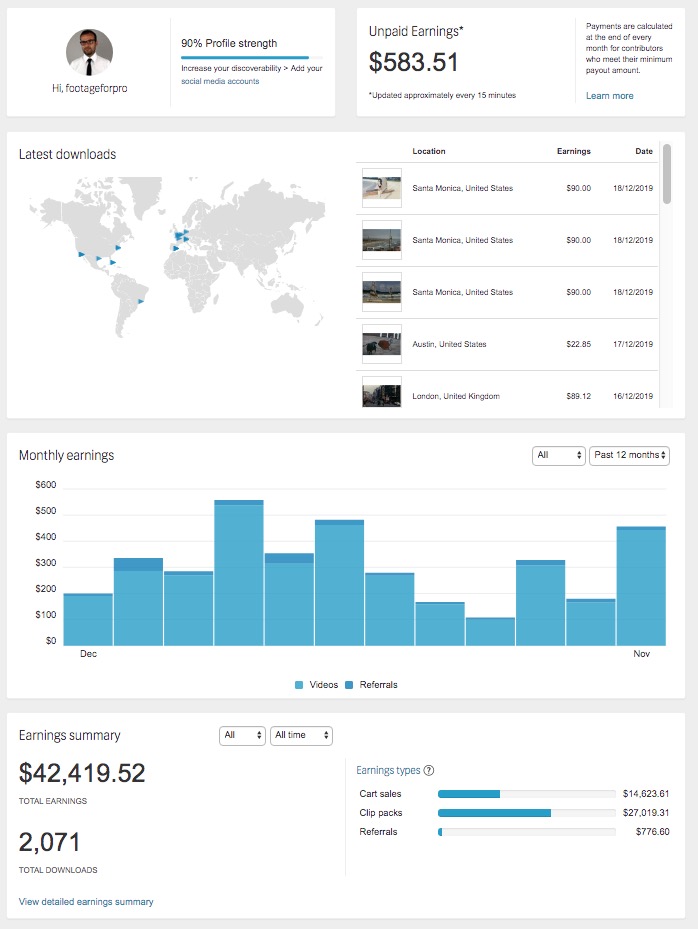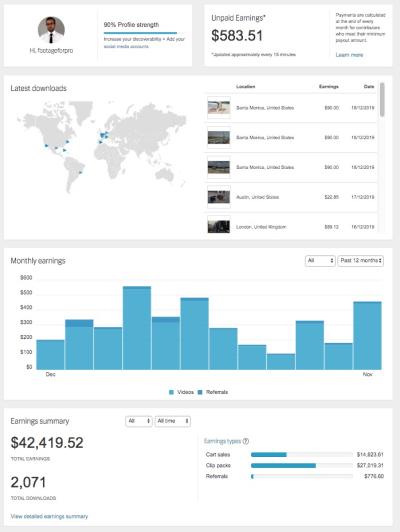Have you ever wondered how photographers and creators earn money just by sharing their photos online? Shutterstock is one of the biggest platforms out there, connecting talented contributors with millions of people looking for images, videos, and music. If you’re thinking about joining or are already part of their community, understanding how they pay contributors is key. In this post, we’ll walk through how Shutterstock’s contribution program works and how they track and credit your sales, so you can get a clear picture of how your work turns into earnings.
How Shutterstock Tracks and Credits Photo Sales

So, you’ve uploaded some stunning photos to Shutterstock—great! But how does the platform keep track of your sales and make sure you get paid? Well, Shutterstock has a pretty sophisticated system to handle this, and understanding it can help you optimize your contributions.
First off, every photo you upload is assigned a unique identifier. This ID helps Shutterstock’s system track each image individually, from the moment it’s uploaded to every download it receives. When someone purchases a license for your photo, the platform logs this transaction in their database, linking it back to your contributor account.
Shutterstock’s tracking system is based on a few key factors:
- Download Type: Shutterstock offers different license types, such as standard and enhanced licenses. Each comes with a different payout rate, and their system tracks which type was purchased.
- Subscription vs. On-Demand Sales: They also differentiate between sales made via subscription plans and individual on-demand purchases. Each has its own payout structure, so your earnings depend on the sale type.
- Geography: The location of the buyer can influence the payout percentage due to regional licensing agreements.
Once a sale is made, the platform calculates your earnings based on your contributor level and the type of sale. Shutterstock’s system automatically credits your account with the corresponding amount, which you can view in your dashboard.
It’s also worth noting that Shutterstock’s tracking is quite transparent. You can see detailed reports of your sales, including which images sold, how many times, and the total earnings. This helps you understand which photos are most popular and can guide your future uploads.
In summary, Shutterstock uses a combination of unique identifiers, detailed transaction logs, and flexible payout rules to ensure that every sale is accurately tracked and credited. This system ensures you’re paid fairly for your creative work, and staying informed about how sales are tracked can help you maximize your earnings and improve your contribution strategy.
Payment Structure and Revenue Share for Contributors
When it comes to earning on Shutterstock, understanding how the payment structure works is essential for any aspiring contributor. Shutterstock operates on a revenue share model, meaning the amount you earn from each sale depends on several factors, including your contributor level, the type of license purchased, and your overall sales volume.
Here’s a quick rundown of the key points:
- Standard Royalty Rates: Shutterstock offers standard royalty rates that typically range from 15% to 30% of the sale price. The exact percentage can vary based on your contributor level and the type of license (Royalty-Free or Enhanced).
- Contributor Levels: Shutterstock has a tiered system that rewards consistent contributors. As you make more sales, you can move up levels—starting from Standard Contributor to Platinum. Higher levels usually come with increased royalty percentages, meaning more earnings per sale.
- Extended and Enhanced Licenses: These licenses generate higher payouts because they are more expensive. Contributors earn a percentage of the license fee, which is often higher than the standard license share.
- Download Count and Sales Volume: The more you sell, the more you earn overall. Shutterstock rewards top contributors with better rates and additional perks as their sales grow.
It’s also worth noting that Shutterstock has a clear structure that ensures transparency. Your earnings are calculated based on a percentage of the license fee, which is set according to the license type and your contributor level. This model encourages creators to upload high-quality, in-demand images, as increased sales directly translate into higher earnings.
Remember, the key to maximizing your earnings is consistency. Regular uploads, keyword optimization, and engaging with trending topics can help boost your sales and, consequently, your revenue share. Keep an eye on your dashboard to track your progress and see how your sales are impacting your overall payout.
Methods of Payment and Payout Schedule
So, you’ve uploaded your stunning photos, and now you’re eager to get paid. Shutterstock offers several convenient methods to receive your earnings, along with a predictable payout schedule that helps you plan your finances.
Methods of Payment:
- PayPal: One of the most popular options, PayPal is quick and easy. You’ll need to link your PayPal account to your Shutterstock contributor account, and payouts are typically processed within a few business days.
- Payoneer: Similar to PayPal, Payoneer is widely used by contributors around the world. It’s a great option if you prefer a prepaid MasterCard or direct bank transfers.
- Bank Transfer (Wire Transfer): Available for some countries, wire transfers deposit your earnings directly into your bank account. Keep in mind, this option might involve higher fees and longer processing times.
- PayPal Local Currency: Shutterstock can send your payments in your local currency if your PayPal account is set up accordingly, reducing currency conversion fees.
Payout Schedule:
Shutterstock operates on a monthly payout cycle. Typically, your earnings are accumulated throughout the month and are processed around the 15th of the following month. For example, sales made in January will generally be paid out by mid-February.
Important things to keep in mind:
- Minimum Payout Threshold: You need to reach a minimum earning threshold—usually $35—before a payout is released.
- Payment Processing Time: Once your earnings are processed, actual receipt time depends on your chosen method. PayPal and Payoneer payouts are usually quicker, often within a few days.
- Tax and Legal Considerations: Depending on your country, you may need to provide tax information or complete tax forms to comply with local laws and receive payments without issues.
In summary, Shutterstock makes it straightforward to get paid through various methods, with a consistent payout schedule. Just ensure your payment details are up to date in your account settings, and you’re all set to enjoy your earnings. Staying informed about payout dates and thresholds helps you plan your income flow and keeps the process smooth.
Tips for Maximizing Earnings on Shutterstock
Loading your portfolio with high-quality, in-demand images is just the beginning. If you’re serious about boosting your earnings on Shutterstock, there are several smart strategies you can adopt to make the most out of your contributions.
1. Focus on Popular and Trending Topics: Keep an eye on current trends, seasonal themes, and popular search terms. For example, images related to remote work, sustainability, or health are often in high demand. Using keyword tools or browsing Shutterstock’s trending sections can give you ideas on what buyers are looking for.
2. Optimize Your Keywords: Effective keywording is crucial. Use relevant, specific, and varied keywords to increase the chances of your images appearing in search results. Think like a buyer—what terms would they use to find your photo? Also, avoid keyword stuffing; keep it natural and relevant.
3. Diversify Your Portfolio: Don’t put all your eggs in one basket. Upload a variety of images—portrait, landscape, conceptual, macro, and more. This not only broadens your reach but also increases the chances of multiple sales across different categories.
4. Maintain High Technical Quality: Ensure your images are sharp, well-lit, and properly exposed. Use good editing practices to enhance colors and clarity. Shutterstock reviewers prioritize high-quality submissions, and quality can impact your acceptance rate and earning potential.
5. Regularly Upload New Content: Consistency pays off. The more fresh images you add, the higher your chances of appearing in relevant searches. Set a schedule that works for you—whether it’s weekly or bi-weekly—and stick to it.
6. Engage with the Community and Keep Learning: Join contributor forums, attend webinars, and read Shutterstock’s contributor resources. Learning from others’ experiences and staying updated on platform changes can give you a competitive edge.
7. Promote Your Portfolio: Share your images on social media, personal websites, or blogs. While Shutterstock traffic is primary, external promotion can attract more buyers to your portfolio and increase sales.
By implementing these tips, you can steadily increase your visibility, attract more customers, and ultimately maximize your earnings on Shutterstock. Remember, patience and persistence are key—building a successful contributor profile takes time, but with dedication, the rewards can be substantial.
Conclusion and Final Thoughts on Shutterstock Contributor Payments
Understanding how Shutterstock pays its contributors is essential if you’re looking to turn your photography hobby into a reliable income stream. The platform offers a straightforward royalty system based on your earnings tier, which is primarily influenced by your total lifetime earnings and the type of download (standard vs. enhanced). As you sell more images and climb higher in the contributor ranks, your payout percentages increase, giving you more value for each sale.
One of the great aspects of Shutterstock is its transparent and predictable payment structure. You can track your sales and earnings via your contributor dashboard, giving you a clear picture of what to expect each month. Payments are made via PayPal or Skrill, and there’s a minimum payout threshold—usually around $35—before you receive your earnings. This setup ensures you can plan and manage your income effectively.
While the earning potential is promising, it’s important to remember that success on Shutterstock, like any marketplace, requires consistent effort, quality work, and strategic promotion. By focusing on creating high-demand images, optimizing keywords, and staying active on the platform, you position yourself for better sales and higher earnings over time.
In conclusion, Shutterstock provides a viable platform for photographers, illustrators, and visual content creators to monetize their work. Understanding the payment system helps you set realistic goals and develop effective strategies. Keep honing your skills, stay current with trends, and be patient—your efforts can lead to a rewarding and sustainable photography business on Shutterstock.


